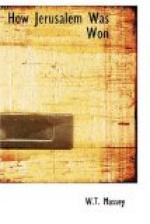General Headquarters directed that two infantry divisions should advance to the line Julis-Hamameh in support of mounted troops, and the 75th Division was accordingly ordered from its position east of Gaza up to Beit Hanun. On the 9th November the 52nd Division was again advancing. The 156th Brigade had moved forward from the Gaza trenches. One officer, five grooms, and two signallers mounted on second horses formed a little party to reconnoitre Askalon, and riding boldly into the ancient landing place of the Crusader armies captured the ruined town unaided. There are visible remains of its old strength, but the power of Askalon has departed. It still stands looking over the blue Mediterranean as a sort of watch tower, a silent, deserted outpost of the land the Crusaders set their hearts on gaining and preserving for Christianity, but behind it is many centuries’ accumulation of sand encroaching upon the fertile plain, and no effort has been made to stop the inroad. The gallant half-dozen having reported to the 156th Brigade that Askalon was open to them—the Brigade occupied the place at noon—rode across the sand-dunes to the important native town of Mejdel, where there was a substantial bazaar doing a good trade in the essentials for native existence, beans and cereals in plenty, fruit, and tobacco of execrable quality. At Mejdel the six accepted the surrender of a body of Turks guarding a substantial ammunition dump and rejoined their units, satisfied with the day’s adventure. The Turks had retired a considerable distance during the day. The principal body was moving up what is called the main road from Deir Sineid, through Beit Jerjal to Julis, to get to Suafir esh Sherkiyeh, Kustineh, and Junction Station, from which they could reach Latron by a metalled road, or Ramleh by a hard mud track by the side of their railway. They were clearly going to oppose us all the way or they would lose the whole of their material, and their forces east and west of the road were well handled in previously selected and partially prepared positions.




